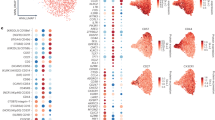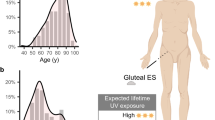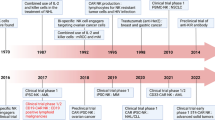Abstract
Lung cancer is the most common cancer and one of the leading causes of cancer-related deaths in the world, however, the treatment of non-small cell lung cancer (NSCLC) is still limited, and it is a clinically urgent problem. ROBO1 is an important surface receptor on tumor cells, but the role of humanized chimeric antigen receptor (CAR) modified natural killer (NK) cells targeting ROBO1 in NSCLC is rarely explored. Furthermore, the role of PD-1 in NK cell killing tumor cells remains controversial. In this study, we identified the expression pattern of ROBO1 in lung squamous cell carcinoma (LUSC) by searching biological information databases. We constructed hROBO1-CAR-NK-92 cells and performed functional identification.We inserted the hROBO1-CAR at the PD-1 locus and performed functional detection in vitro and in vivo. The results showed that ROBO1 expression was significantly increased in LUSC. After inserting the hROBO1-CAR sequence at the PD-1 locus, the PD-1-KO-hROBO1-CAR-NK-92 cells had the best long-term killing ability and cytokine secretion ability, and had a significant inhibitory effect on tumor growth in the mouse xenograft model. We also observed that the long-term killing ability of PD-1-KO-hROBO1-CAR-NK-92 cells was achieved by inhibiting cell senescence via knocking out PD-1. These studies proposed ROBO1 as a key target for CAR-NK therapy in NSCLC and integrated hROBO1 CAR in PD-1 locus in NK cells, resulting in synergistic tumor killing effects in NSCLC, presenting a new treatment strategy for solid tumor treatment.

This is a preview of subscription content, access via your institution
Access options
Subscribe to this journal
Receive 12 print issues and online access
$259.00 per year
only $21.58 per issue
Buy this article
- Purchase on SpringerLink
- Instant access to full article PDF
Prices may be subject to local taxes which are calculated during checkout








Similar content being viewed by others
Data availability
The datasets generated during and/or analyzed during the current study are available from the corresponding author upon reasonable request.
References
Thai AA, Solomon BJ, Sequist LV, Gainor JF, Heist RS. Lung cancer. Lancet. 2021;398:535–54.
Lahiri A, Maji A, Potdar PD, Singh N, Parikh P, Bisht B, et al. Lung cancer immunotherapy: progress, pitfalls, and promises. Mol Cancer. 2023;22:40.
Fenton GA, Mitchell DA. Cellular cancer immunotherapy development and manufacturing in the clinic. Clin Cancer Res. 2023;29:843–57.
Qian K, Li G, Zhang S, Fu W, Li T, Zhao J, et al. CAR‐T‐cell products in solid tumors: Progress, challenges, and strategies. Interdiscip Med. 2024;2. https://doi.org/10.1002/inmd.20230047.
Liu S, Galat V, Galat Y, Lee YKA, Wainwright D, Wu J. NK cell-based cancer immunotherapy: from basic biology to clinical development. J Hematol Oncol. 2021;14:7.
Klingemann H. The NK-92 cell line-30 years later: its impact on natural killer cell research and treatment of cancer. Cytotherapy. 2023;25:451–7.
Zhang L, Meng Y, Feng X, Han Z. CAR-NK cells for cancer immunotherapy: from bench to bedside. Biomark Res. 2022;10:12.
Velasco-de Andres M, Munoz-Sanchez G, Carrillo-Serradell L, Gutierrez-Hernandez MDM, Catala C, Isamat M, et al. Chimeric antigen receptor-based therapies beyond cancer. Eur J Immunol. 2023;53:e2250184.
Gong Y, Klein Wolterink RGJ, Wang J, Bos GMJ, Germeraad WTV. Chimeric antigen receptor natural killer (CAR-NK) cell design and engineering for cancer therapy. J Hematol Oncol. 2021;14:73.
Jiang L, Sun J, Huang D. Role of Slit/Robo signaling pathway in bone metabolism. Int J Biol Sci. 2022;18:1303–12.
Li HS, Chen JH, Wu W, Fagaly T, Zhou L, Yuan W, et al. Vertebrate slit, a secreted ligand for the transmembrane protein roundabout, is a repellent for olfactory bulb axons. Cell. 1999;96:807–18.
Basha S, Jin-Smith B, Sun C, Pi L. The SLIT/ROBO pathway in liver fibrosis and cancer. Biomolecules. 2023;13. https://doi.org/10.3390/biom13050785.
Erskine L, Williams SE, Brose K, Kidd T, Rachel RA, Goodman CS, et al. Retinal ganglion cell axon guidance in the mouse optic chiasm: expression and function of robos and slits. J Neurosci. 2000;20:4975–82.
Ahirwar DK, Peng B, Charan M, Misri S, Mishra S, Kaul K, et al. Slit2/Robo1 signaling inhibits small-cell lung cancer by targeting beta-catenin signaling in tumor cells and macrophages. Mol Oncol. 2023;17:839–56.
Chang PH, Hwang-Verslues WW, Chang YC, Chen CC, Hsiao M, Jeng YM, et al. Activation of Robo1 signaling of breast cancer cells by Slit2 from stromal fibroblast restrains tumorigenesis via blocking PI3K/Akt/beta-catenin pathway. Cancer Res. 2012;72:4652–61.
Yi M, Zheng X, Niu M, Zhu S, Ge H, Wu K. Combination strategies with PD-1/PD-L1 blockade: current advances and future directions. Mol Cancer. 2022;21:28.
Ghosh C, Luong G, Sun Y. A snapshot of the PD-1/PD-L1 pathway. J Cancer. 2021;12:2735–46.
Hsu J, Hodgins JJ, Marathe M, Nicolai CJ, Bourgeois-Daigneault MC, Trevino TN, et al. Contribution of NK cells to immunotherapy mediated by PD-1/PD-L1 blockade. J Clin Invest. 2018;128:4654–68.
Dammeijer F, van Gulijk M, Mulder EE, Lukkes M, Klaase L, van den Bosch T, et al. The PD-1/PD-L1-checkpoint restrains T cell immunity in tumor-draining lymph nodes. Cancer Cell. 2020;38:685–700.
Hu Y, Zu C, Zhang M, Wei G, Li W, Fu S, et al. Safety and efficacy of CRISPR-based non-viral PD1 locus specifically integrated anti-CD19 CAR-T cells in patients with relapsed or refractory Non-Hodgkin’s lymphoma: a first-in-human phase I study. EClinicalMedicine. 2023;60:102010.
Deng M, Zeng Y, Liu Y, Wang X, Chen N, Zhang M, et al. Increased PD-1(+) NK cell subset in the older population. Int J Gen Med. 2024;17:651–61.
Li S, Gao K, Yao D. Comprehensive analysis of angiogenesis associated genes and tumor microenvironment infiltration characterization in cervical cancer. Heliyon. 2024;10:e33277.
Zhang W, Dao JJ, Li Q, Liu C, Qiao CM, Cui C, et al. Neuregulin 1 mitigated prolactin deficiency through enhancing TRPM8 signaling under the influence of melatonin in senescent pituitary lactotrophs. Int J Biol Macromol. 2024;275:133659.
Peng Y, Zhang W, Chen Y, Zhang L, Shen H, Wang Z, et al. Engineering c-Met-CAR NK-92 cells as a promising therapeutic candidate for lung adenocarcinoma. Pharm Res. 2023;188:106656.
Kang W, Ye C, Yang Y, Lou YR, Zhao M, Wang Z, et al. Identification of anoikis-related gene signatures and construction of the prognosis model in prostate cancer. Front Pharm. 2024;15:1383304.
Tsai SQ, Zheng Z, Nguyen NT, Liebers M, Topkar VV, Thapar V, et al. GUIDE-seq enables genome-wide profiling of off-target cleavage by CRISPR-Cas nucleases. Nat Biotechnol. 2015;33:187–97.
Kath J, Du W, Pruene A, Braun T, Thommandru B, Turk R, et al. Pharmacological interventions enhance virus-free generation of TRAC-replaced CAR T cells. Mol Ther Methods Clin Dev. 2022;25:311–30.
Pesini C, Hidalgo S, Arias MA, Santiago L, Calvo C, Ocariz-Diez M, et al. PD-1 is expressed in cytotoxic granules of NK cells and rapidly mobilized to the cell membrane following recognition of tumor cells. Oncoimmunology. 2022;11:2096359.
Quixabeira DCA, Pakola S, Jirovec E, Havunen R, Basnet S, Santos JM, et al. Boosting cytotoxicity of adoptive allogeneic NK cell therapy with an oncolytic adenovirus encoding a human vIL-2 cytokine for the treatment of human ovarian cancer. Cancer Gene Ther. 2023;30:1679–90.
Liu M, Huang W, Guo Y, Zhou Y, Zhi C, Chen J, et al. CAR NK-92 cells targeting DLL3 kill effectively small cell lung cancer cells in vitro and in vivo. J Leukoc Biol. 2022;112:901–11.
Hoy SM. Sintilimab: first global approval. Drugs. 2019;79:341–6.
Tao JH, Zhang J, Li HS, Zhou Y, Guan CX. Nature killer cell for solid tumors: current obstacles and prospective remedies in NK cell therapy and beyond. Crit Rev Oncol Hematol. 2025;205:104553.
Wu N, Yang N, Zhang S, Wu H, Fang X, Lin W, et al. Chimeric antigen receptor NK cells for breast cancer immunotherapy. Cancer Treat Rev. 2025;137:102943.
Lin H, Yang X, Ye S, Huang L, Mu W. Antigen escape in CAR-T cell therapy: mechanisms and overcoming strategies. Biomed Pharmacother. 2024;178:117252.
Aparicio-Perez C, Carmona M, Benabdellah K, Herrera C. Failure of ALL recognition by CAR T cells: a review of CD 19-negative relapses after anti-CD 19 CAR-T treatment in B-ALL. Front Immunol. 2023;14:1165870.
Dehbashi M, Hojati Z, Motovali-Bashi M, Ganjalikhany MR, Cho WC, Shimosaka A, et al. A novel CAR expressing NK cell targeting CD25 with the prospect of overcoming immune escape mechanism in cancers. Front Oncol. 2021;11:649710.
Ren Y, Xue M, Hui X, Liu X, Farooq MA, Chen Y, et al. Chimeric cytokine receptor TGF-beta RII/IL-21R improves CAR-NK cell function by reversing the immunosuppressive tumor microenvironment of gastric cancer. Pharm Res. 2025;212:107637.
Luo J, Guo M, Huang M, Liu Y, Qian Y, Liu Q, et al. Neoleukin-2/15-armored CAR-NK cells sustain superior therapeutic efficacy in solid tumors via c-Myc/NRF1 activation. Sig Transduct Target Ther. 2025;10:78.
Cichocki F, Goodridge JP, Bjordahl R, Mahmood S, Davis ZB, Gaidarova S, et al. Dual antigen-targeted off-the-shelf NK cells show durable response and prevent antigen escape in lymphoma and leukemia. Blood. 2022;140:2451–62.
Gong Y, Chen W, Chen X, He Y, Jiang H, Zhang X, et al. An injectable epigenetic autophagic modulatory hydrogel for boosting umbilical cord blood NK cell therapy prevents postsurgical relapse of triple-negative breast cancer. Adv Sci. 2022;9:e2201271.
Liu X, Song J, Zhang H, Liu X, Zuo F, Zhao Y, et al. Immune checkpoint HLA-E:CD94-NKG2A mediates evasion of circulating tumor cells from NK cell surveillance. Cancer Cell. 2023;41:272–87.
Yuan M, Guo H, Li J, Sui C, Qin Y, Wang J, et al. Slit2 and Robo1 induce opposing effects on metastasis of hepatocellular carcinoma Sk-hep-1 cells. Int J Oncol. 2016;49:305–15.
Waldmann H. Human monoclonal antibodies: the benefits of humanization. Methods Mol Biol. 2019;1904:1–10.
Alejandra WP, Miriam Irene JP, Fabio Antonio GS, Patricia RR, Elizabeth TA, Aleman-Aguilar JP, et al. Production of monoclonal antibodies for therapeutic purposes: a review. Int Immunopharmacol. 2023;120:110376.
Liu E, Marin D, Banerjee P, Macapinlac HA, Thompson P, Basar R, et al. Use of CAR-transduced natural killer cells in CD19-positive lymphoid tumors. N Engl J Med. 2020;382:545–53.
Farooq R, Hussain K, Nazir S, Javed MR, Masood N. CRISPR/Cas9; a robust technology for producing genetically engineered plants. Cell Mol Biol. 2018;64:31–8.
Shi J, Li S, Shao R, Jiang Y, Qiao Y, Liu J, et al. Electrochemiluminescence aptasensing method for ultrasensitive determination of lipopolysaccharide based on CRISPR-Cas12a accessory cleavage activity. Talanta. 2024;272:125828.
Balke-Want H, Keerthi V, Gkitsas N, Mancini AG, Kurgan GL, Fowler C, et al. Homology-independent targeted insertion (HITI) enables guided CAR knock-in and efficient clinical scale CAR-T cell manufacturing. Mol Cancer. 2023;22:100.
Glaser V, Flugel C, Kath J, Du W, Drosdek V, Franke C, et al. Combining different CRISPR nucleases for simultaneous knock-in and base editing prevents translocations in multiplex-edited CAR T cells. Genome Biol. 2023;24:89.
Zhang J, Hu Y, Yang J, Li W, Zhang M, Wang Q, et al. Non-viral, specifically targeted CAR-T cells achieve high safety and efficacy in B-NHL. Nature. 2022;609:369–74.
Budimir N, Thomas GD, Dolina JS, Salek-Ardakani S. Reversing T-cell exhaustion in cancer: lessons learned from PD-1/PD-L1 immune checkpoint blockade. Cancer Immunol Res. 2022;10:146–53.
Cichocki F, Bjordahl R, Gaidarova S, Mahmood S, Abujarour R, Wang H, et al. iPSC-derived NK cells maintain high cytotoxicity and enhance in vivo tumor control in concert with T cells and anti-PD-1 therapy. Sci Transl Med. 2020;12. https://doi.org/10.1126/scitranslmed.aaz5618.
Gray KD, McCloskey JE, Vedvyas Y, Kalloo OR, Eshaky SE, Yang Y, et al. PD1 blockade enhances ICAM1-directed CAR T therapeutic efficacy in advanced thyroid cancer. Clin Cancer Res. 2020;26:6003–16.
Gao Y, Chi Y, Chen Y, Wang W, Li H, Zheng W, et al. Multi-omics analysis of human mesenchymal stem cells shows cell aging that alters immunomodulatory activity through the downregulation of PD-L1. Nat Commun. 2023;14:4373.
Wang TW, Johmura Y, Suzuki N, Omori S, Migita T, Yamaguchi K, et al. Blocking PD-L1-PD-1 improves senescence surveillance and ageing phenotypes. Nature. 2022;611:358–64.
Pippin JW, Kaverina N, Wang Y, Eng DG, Zeng Y, Tran U, et al. Upregulated PD-1 signaling antagonizes glomerular health in aged kidneys and disease. J Clin Invest. 2022;132.
Ogrodnik M. Cellular aging beyond cellular senescence: markers of senescence prior to cell cycle arrest in vitro and in vivo. Aging Cell. 2021;20:e13338.
Wong JKM, McCulloch TR, Alim L, Omer N, Mehdi AM, Tuong ZK, et al. TGF-beta signalling limits effector function capacity of NK cell anti-tumour immunity in human bladder cancer. EBioMedicine. 2024;104:105176.
Chen B, Liu X, Yu P, Xie F, Kwan JSH, Chan WN, et al. H. pylori-induced NF-kappaB-PIEZO1-YAP1-CTGF axis drives gastric cancer progression and cancer-associated fibroblast-mediated tumour microenvironment remodelling. Clin Transl Med. 2023;13:e1481.
Viel S, Marcais A, Guimaraes FS, Loftus R, Rabilloud J, Grau M, et al. TGF-beta inhibits the activation and functions of NK cells by repressing the mTOR pathway. Sci Signal. 2016;9:ra19.
Funding
This study was supported by the National Natural Science Foundation of China (82241053), Fundamental Research Funds for the Central Universities of Central South University (2020zzts772), Hunan Provincial Innovation Foundation for Postgraduate (CX20220321), and Postgraduate Innovative Project of Central South University (2021XQLX51).
Author information
Authors and Affiliations
Contributions
JHT, JZ, HSL, YZ and CXG conceptualized and designed this study. JHT performed most of the experiments, and J.Z performed partial experiments. JZ, CYT, JXD, CYZ, and YBL executed the acquisition and analysis of data. JHT, JZ and LJ prepared figures, performed statistical analysis, and wrote the manuscript. JHT, JZ, HSL,YZ, CXG, JXD, CYZ, YBL and LJ provided administrative, technical, or material support. All authors read and approved the final manuscript.
Corresponding authors
Ethics declarations
Competing interests
The authors declare no competing interests.
Ethics approval
The experimental use of mice in the present study was approved by the Ethics Committee of the Institute of Clinical Pharmacology of Central South University (No. 2021-XMSB-0194) to keep with the guidelines of the National Institutes of Health.
Additional information
Publisher’s note Springer Nature remains neutral with regard to jurisdictional claims in published maps and institutional affiliations.
Supplementary information
Rights and permissions
Springer Nature or its licensor (e.g. a society or other partner) holds exclusive rights to this article under a publishing agreement with the author(s) or other rightsholder(s); author self-archiving of the accepted manuscript version of this article is solely governed by the terms of such publishing agreement and applicable law.
About this article
Cite this article
Tao, JH., Zhang, J., Tang, CY. et al. Integration of humanized ROBO1 CAR in PD-1 locus in natural killer cells delivers synergistic tumor-killing effect against non-small cell lung cancer. Cancer Gene Ther (2025). https://doi.org/10.1038/s41417-025-00957-x
Received:
Revised:
Accepted:
Published:
DOI: https://doi.org/10.1038/s41417-025-00957-x



